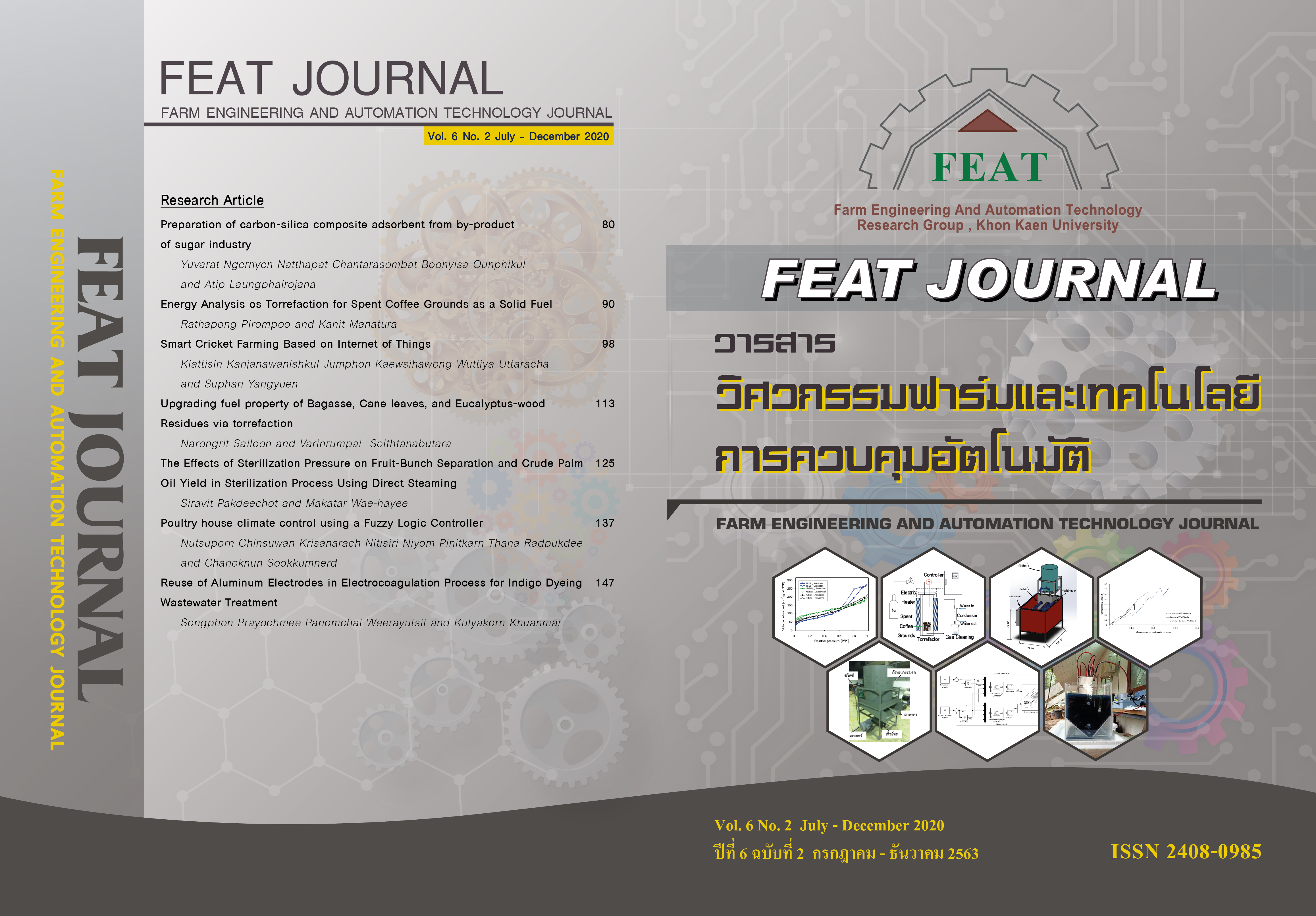การวิเคราะห์พลังงานจากการทอริแฟกชั่นของกากกาแฟสำหรับการเป็นเชื้อเพลิงแข็ง
Main Article Content
บทคัดย่อ
การวิเคราะห์คุณสมบัติการทอริแฟกชั่นและประสิทธิภาพเชิงพลังงานของกากกาแฟอัดเม็ดภายใต้อุณหภูมิ (200, 250, 275 และ 300 องศาเซลเซียส) และระยะเวลา (30, 45 และ 60 นาที) ได้ถูกนำเสนอในงานวิจัยนี้ โดยใช้ค่าประสิทธิภาพเชิงพลังงานสัมพัทธ์ (Relative Energy Efficiency, REE) เป็นดัชนีบ่งบอกประสิทธิภาพการใช้พลังงานในการปรับสภาพชีวมวล ผลจากการทดลองพบว่า อุณหภูมิที่เพิ่มขึ้นจากการทอริแฟกชั่นส่งผลให้อัตราส่วนอะตอมของ H/C และ O/C ผลผลิตเชิงมวล และผลผลิตเชิงพลังงานมีค่าลดลง ขณะที่ความหนาแน่นเชิงพลังงานมีค่าเพิ่มขึ้น นอกจากนี้ ประสิทธิภาพเชิงพลังงานสัมพัทธ์ชี้ให้เห็นว่าที่อุณหภูมิทอริแฟกชั่นสูง (275 ถึง 300 องศาเซลเซียส) ระยะเวลาทอริแฟกชั่นที่สั้น (30 นาที) มีการใช้พลังงานอย่างมีประสิทธิภาพมากกว่าที่อุณหภูมิทอริแฟกชั่นต่ำ (200 ถึง 250 องศาเซลเซียส) ระยะเวลานาน (60 นาที) ซึ่งการทอริแฟกชั่นที่ 300 องศาเซลเซียส ระยะเวลา 30 นาที มีค่าความร้อนสูง (HHV) เท่ากับ 28.2 เมกะจูล/กิโลกรัม ซึ่งให้ค่าประสิทธิภาพเชิงพลังงานสัมพัทธ์ที่เหมาะสมที่สุด
Article Details
วารสารวิศวกรรมฟาร์มและเทคโนโลยีควบคุมอัตโนมัติ (FEAT Journal) มีกําหนดออกเป็นราย 6 เดือน คือ มกราคม - มิถุนายน และกรกฎาคม - ธันวาคม ของทุกปี จัดพิมพ์โดยกลุ่มวิจัยวิศวกรรมฟาร์มและเทคโนโลยีควบคุมอัตโนมัติ คณะวิศวกรรมศาสตร์มหาวิทยาลัยขอนแก่น เพื่อเป็นการส่งเสริมและเผยแพร่ความรู้ ผลงานทางวิชาการ งานวิจัยทางด้านวิศวกรรมศาสตร์และเทคโนโลยีพร้อมทั้งยังจัดส่ง เผยแพร่ตามสถาบันการศึกษาต่างๆ ในประเทศด้วย บทความที่ตีพิมพ์ลงในวารสาร FEAT ทุกบทความนั้นจะต้องผ่านความเห็นชอบจากผู้ทรงคุณวุฒิในสาขาที่เกี่ยวข้องและสงวนสิทธิ์ ตาม พ.ร.บ. ลิขสิทธิ์ พ.ศ. 2535
References
Agbor, E., Zhang, X. and Kumar, A. (2014). A review of biomass co-firing in North America, Renewable and Sustainable Energy Reviews, vol. 40, December 2014, pp. 930-943.
Department of Alternative Energy Development and Efficiency, Ministry of Energy, Thailand (2019). Statistic Data, URL: https://www.dede.go.th, access on 10/03/2019.
กรุงเทพธุรกิจ. คนไทยเสพติดกาแฟดันตลาด 'หมื่นล้าน', [ระบบออนไลน์], แหล่งที่มาhttps://www.bangkokbiznews.com, เข้าดูเมื่อวันที่ 8/03/2562.
คณะทันตแพทย์ศาสตร์ จุฬาลงกรณ์มหาวิทยาลัย. กาแฟ (Coffee), [ระบบออนไลน์], แหล่งที่มาhttps://www.anatomy.dent.chula.ac.th, เข้าดูเมื่อวันที่ 15/01/2562.
ดุษฎีพร สิทธิกุล (2556). คุณสมบัติของชีวมวลในกระบวนการทอรีแฟคชั่น, [ระบบออนไลน์], แหล่งที่มา https://www.thapra.lib.su.ac.th, เข้าดูเมื่อวันที่ 19/10/2561.
Basu, P. (2018). Biomass gasification, pyrolysis and torrefaction: practical design and theory. Academic press. San Diego.
Granados, D.A., Ruiz, R.A., Vega, L.Y., Chejne, F. (2017). Study of reactivity reduction in sugarcane bagasse as consequence of a torrefaction process, Energy, vol.139, pp. 818-827.
Zhang, C., Ho, S. H., Chen, W.H., Xie, Y., Liu, Z., Chang, J.S. (2018). Torrefaction performance and energy usage of biomass wastes and their correlations with torrefaction severity index, Applied Energy, vol.220, pp. 598-604.
Du, S.W., Chen, W.H., Lucas, J.A. (2014). Pretreatment of biomass by torrefaction and carbonization for coal blend used in pulverized coal injection, Bioresource Technology, vol.161, pp. 333-339.
Prins, M. J., Ptasinski, K. J., Janssen, F. J. (2006). More efficient biomass gasification via torrefaction. Energy, vol 31(15), pp. 3458-3470.
Çengel, Y. A., Boles, M. A. (2008). Thermodynamics: an engineering approach,-PDF. McGraw-Hill.
Chen, W.H., Huang, M.Y., Chang, J.S., Chen, C.Y., Lee, W.J. (2015). An energy analysis of torrefaction for upgrading microalga residue as a solid fuel, Bioresource technology, vol. 185, June 2015, pp. 285-293.

